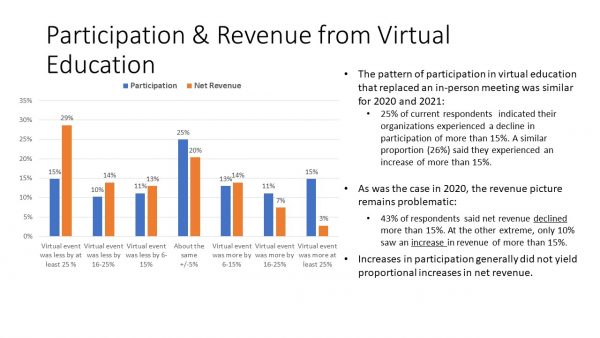Normal Left the Party—Survey Reveals Associations Want Her Back

What should we call it—the New Normal, the Next Normal, Another Normal? Please let go of normal. When the DJ stopped playing oldies, Normal left the party. Since well before the pandemic, I’ve been urging my colleagues and clients to consider that stability in the digital marketplace is a dangerous illusion.
Guiding our association clients toward successful solutions means that the .orgSource team operates with one foot in the future and the other grounded in the reality of our community. To learn where associations stand on an evolving business continuum, we regularly survey our constituents.
This year we book-ended the pandemic, rolling out one survey in July/August 2020 and distributing another as the vaccines were arriving in April 2021. The questions in both were designed to provide perspective on changing attitudes about the pandemic’s impact and its implications for the future.
We were eager to understand if adaptations made in response to COVID-19 resulted in permanent alterations to operations and business models. Learning whether our community is becoming more resilient by embracing the technology trends that are reshaping the marketplace was also important.
More than 100 executives participated in the current survey. The majority, or 73%, represented professional associations. Two-thirds were members of senior management. Half of the respondents represented organizations with budgets under $5 million, while one-fifth had budgets of at least $15 million.
Consider Change
The demographics and results of the second survey were consistent with the previous study. The earlier survey highlighted two divergent points of view. There was a general understanding that COVID-19 was creating significant shifts in the association paradigm.
A total of 73% of participants agreed, or strongly agreed, that the pandemic was accelerating trends requiring changes in the role of associations, their underlying business model, and their strategic direction. Also, 54% strongly agreed that shifts in the environment might threaten the viability of many groups.
This was the disconnect. A surprising number of participants did not anticipate, and were not considering, the need for any significant post-pandemic change. Just under half, or 40%, did not foresee any long-term revisions to their product portfolio. Almost 60% believed their membership models would resume pre-pandemic patterns, and 41% saw in-person networking opportunities returning to the status quo. Many participants also commented that their mission and vision would remain unchanged.
Adopt Digital Thinking
I urge clients to make digital thinking the center of operations and culture. The bright spot that I saw in the pandemic experience was technology’s make-or-break role. It seemed that “survival of the digitized” might inspire organizations to reimagine their potential. My vision wasn’t about technical capacity, although systems play a critical role.
I hoped there might be a strong trend toward insightful exploration of how digital tools can expand and deepen associations’ relationships with members, sponsor/partners, and their publics. The .orgSource team includes experts in marketing, strategy, and technology, but we are all focused on an end game of success through digital transformation.
Reinventing business processes can be difficult, but changing how we think is even more challenging. So, I wasn’t surprised to see that the same dichotomy that existed in 2020 was evident in the 2021 responses. The majority of participants (70%) viewed the pandemic as an agent of significant disruption; however, most groups appear to remain focused on superficial responses and have not chosen to take the deep dive into foundational changes to business models, vision, or mission.
While COVID-19 pushed us toward digital solutions, it did not seem to spark technology-centered problem-solving or the need to reimagine new roles and ways of providing service. For example, although there was strong agreement that the pandemic would lead to lasting changes in virtual education, approximately 40% of respondents felt that in-person education would return to pre-pandemic patterns.
Most participants continued to struggle with generating revenue from their online initiatives: 43% said net revenue declined more than 15%. At the other extreme, only 10% saw gains of more than 15%. Greater participation generally did not yield proportional returns in net revenue.
Recognize Uncertainty

In the area of membership, most organizations anticipate a return to the status quo. Sixty-two percent of respondents felt that their membership model would revert to the pre-pandemic pattern, a slight increase from 58% in 2020.
Despite their confidence in a rebound in significant revenue generators like events and membership, most respondents continued to be uncertain about their group’s ability to successfully adapt and change. Less than 35% of participants agreed or strongly agreed that their organizations have these keys to long-term success in place:
- A vision of where they are headed
- An operational plan to achieve profitability
- Adequate technology; information resources and business intelligence systems
- A clear digital strategy to support innovation
Cultivate Association 4.0 Qualities
What is the antidote to going beyond Band-Aids toward stable solutions, and why is it necessary for associations to reevaluate their business strategies?
Although a pandemic was the source of the current disruption, Industry 4.0, or the explosion of cyberspace and its many galaxies, continues to foil efforts to maintain the status quo. New technology replaces time-honored business practices as easily as a kid toppling Legos.
At .orgSource we believe that digital thinking and digital transformation are fundamental to moving through this volatile environment with confidence. We’ve identified what we call Association 4.0 habits or these seven qualities that help organizations thrive in an uncertain environment.
- Focused vision: Understand why your organization exists and what is most important about your mission. Prioritize initiatives accordingly.
- Be adaptive, flexible, nimble: Develop strategies and tactics that are future-oriented and constantly evolving. Don’t be afraid to experiment. Quickly abandon initiatives that are not working.
- Innovate and learn to manage risk: Business as usual is not an option. Culture should support growth and change, reward professional development, and encourage creativity.
- Build for action: Create systems that promote efficient decision-making and delegated/decentralized authority.
- Develop robust business intelligence systems: Use data analytics to support decision-making. Incorporate environmental scanning and real-time feedback into routine business practices.
- Invest in enabling technologies: Make digital transformation a core strategy, and integrate systems, processes, and people throughout the organization.
- Maintain financial health: Develop diverse revenue streams to fund operations as well as provide the capital resources to invest in transformative change.
The April survey reveals that association leaders are cautiously optimistic about the future. After a stressful year, it’s refreshing to see colleagues looking forward to in-person meetings and networking. Most of us are eager to exchange information with each other in a face-to-face setting, and there will certainly be a surge in attendance at these events. Remote work and virtual education are here to stay, and organizations continue to learn and refine their approaches to both strategies.
It’s comforting that we can rebound from an existential threat so quickly. But it would not be wise to allow newfound confidence to become complacence. Use this pause to assess your progress. Measure people, culture, and systems against the seven qualities listed above.
There isn’t a tip big enough to coax the DJ into spinning last year’s playlist, and Normal is not making a comeback. But taking an Association 4.0 approach to the future assures that you won’t miss her.
